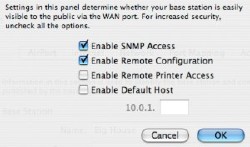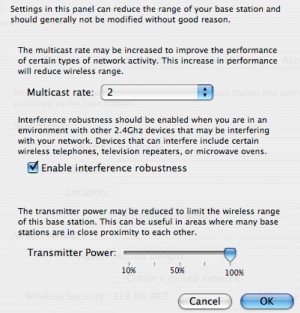The Airport Tab
This tab contains some of the identity information for your ABS.
The Base Station Section
- This section starts off with the name of your ABS which I usually use for location information. I use it to remind me where the ABS is installed, which is very useful in roaming environments (i.e. an installation with multiple ABS' on the same network that you can share by walking around the house). Given that any Admin Utility can show the name of available base stations, I would not mention street address', etc. Instead, mention mundane locations (i.e. "Office", "Laundry", etc.)
- The next two lines are for contact info and I have never seen a use for them. There seems to be no way to access this information without having administrator access to the base station. As such, entering information here is pointless, unless you're installing a network for folks and want to give them a friendly reminder how to reach you.
- However, the next button is VERY important. Regardless of how comfy you feel about the world out there, it is IMPERATIVE that you change the ABS password from the default "public" as soon as possible. I have been quite amused to fire up my Admin utility, find other people's ABS' right through the cable modem network, and discover that their ABS' still use the default password.
If you don't have a difficult to guess password, you are inviting trouble. For example, a hacker might change your password, locking you out of your own ABS, change the configuration to be incompatible with your network, have your ABS dial 1-900 numbers instead of your ISP, etc. So update the password right away. - The "WAN Privacy" button governs what folks can do with your ABS via the WAN port. For example, you can decide whether someone should be able to administer the base station via the WAN port. By default, you want to un-check all the boxes because enabling any of them allows people connected to the upstream network to connect to your AEBS and potentially change its settings. For example, this could be anyone attached to the cable or DSL network.
In a corporate setting, enabling such access might be useful because it allows a network administrator to change all ABS settings from one central location. For the typical home user, WAN Access is pointless because they'd contact the ABS either via the LAN Ethernet port or the wireless connection. The Default Host Setting is useful if you want to set your IP Settings manually.


The Airport Network Section
The next section in the screen relates to the network name, encryption, etc. The number of features here are a function of what version of the software you are using. The higher the firmware/software version, the more features that will be available.
- The first line allows you to enter a Network Name. If you want to create a roaming network at some point, this is the name that has to be the same for every ABS in order to allow seamless hand-offs between base stations. But even if you don't have multiple ABS' on a network, a "Network Name" is very important since it is required for your wireless computers to connect in the first place.
I would not name your network after a street address or a family name, as it makes your house too easy to identify. Instead, use a whimsical name that is nonsensical to anyone but yourself... - Creating closed networks is a quasi-security measure. A "closed" network will not broadcast its presence continuously. However, any network traffic will. Thus, if you actually use your network, then detection tools like MacStumbler (Mac OS X), ClassicStumbler (Mac OS 9), or Netstumbler (Windows) will still detect it. Meanwhile, closing a network will inconvenience legitimate users since it forces them to enter the network name before they can join it.
- By clicking on the "Change Wireless Security", you can enable encryption on your network. Doing so is a very good idea, for the reasons outlined on my Encryption page). With the right firmware, Extreme base stations support Personal WPA, which is quite secure. If all the computers on your wireles network allow the use of Personal WPA, I'd use that, otherwise go for 128bit WEP.
- You can now select a channel to transmit on. I would leave the setting on Automatic and let the base station figure out what the least congested channel is. Yoru computer will find the ABS automatically, regardless of what channel it is using.
- You can also select a channel to transmit on. I usually use one the Stumbler programs (see above) to see which channels are already being used by other people in the area. Then I chose a channel on the ABS as far away from the rest as possible. Usually, channel 1 or 11 are the best choice, as most access points seem to be set up for channel 6 by default.
Do ensure that multiple ABS' that are part of a roaming network all transmit on different frequencies wherever they overlap. The "overlapping" areas should be on frequencies at least two channels apart per this Apple article. Otherwise, there will be a lot of interference. Here is a good article from Apple that describes how to set up roaming networks. - Extreme Base Stations can operate in 802.11b and/or 802.11g mode while the two older generations only do 802.11b. In order to take advantage of theoretical 54Mbit/s throughput of a Extreme base station, you'll have to enable 802.11g or 802.11b&g mode. Be aware though that networks containing a mix of 802.11b and 802.11g devices can have interoperability issues. You may have to fall back to the slower but more reliable 802.11b mode. Apple has assembled a list of cards that are not compatible with the 802.11b&g mode.
- The "Wireless Options" allows you to adjust the base station in a number of interesting ways.
- The first option is to adjust the multi-cast rate. This is the minimum speed in Mbit/s that the base station will allow for connections. By default, it is set at 2Mbit/s, but can be lowered to 1Mbit/s for longer range connections. If you have a lot of base stations in close proximity, you may want to increase the multi-cast rate to artificially reduce the range of your base station. This feature can also be a quasi-security measure, confining the ABS signal to a single room, for example.
- Enabling Interference Robustness is a feature which is supposed to make your ABS more resistant to interference from everyday interference sources like microwave ovens, 2.4GHz portable phones, etc. Whether it works or not is a different question. Allegedly, both the computer clients and the access point have to have Interference Robustness turned on in order for it to do its magic. If anyone out there can verify the benefits of Interference Robustness, I'd love to hear about it.
- A "Extreme"-only feature is the ability to adjust the transmitter power. Here is yet another means of making it more difficult for others to intercept your signals - what doesn't exit your premises cannot be picked up outside. Like the multi-cast feature above, the transmitter power may also be used to allow very high densities of base stations without undue interference.

A passive means of increasing security is through the use of "sector" antennas instead of omni-directional ones. For example, you can set up a sector-antenna at the edge of the building to face inwards and away from any adjoining roads. Any hackers roaming the neighborhood will subsequently have a much harder time picking up your signal. See my Antenna discussion page for more information. You can also reduce the transmitter output or adjust the multi-cast rate as described above.


